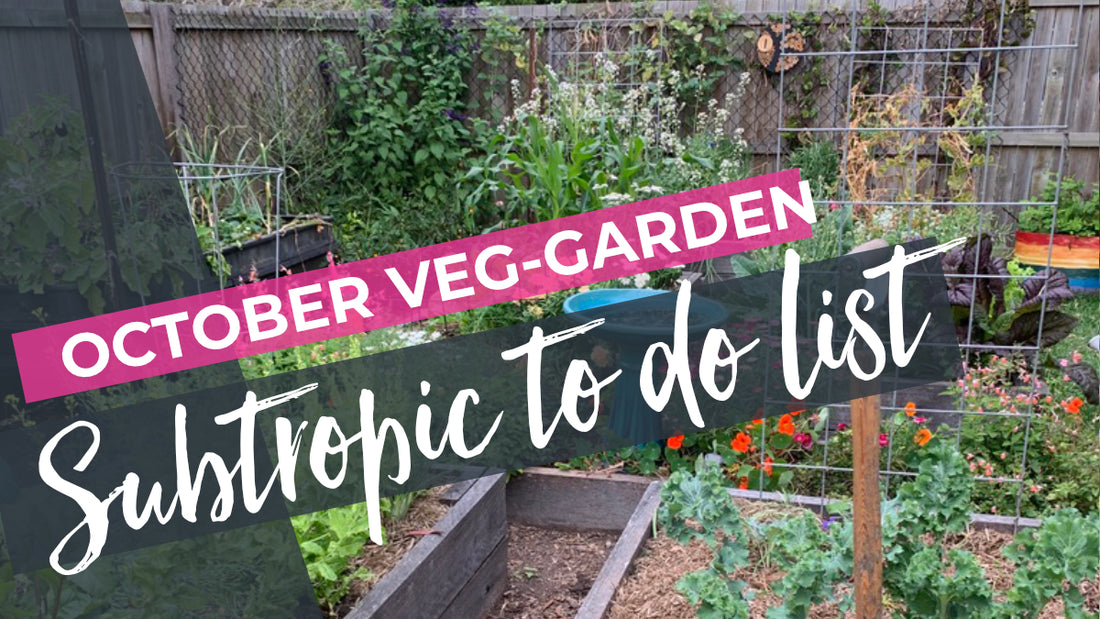October is a time of abundant growth and promise in your subtropical Australian garden. With the arrival of spring, it's an ideal time to focus on growing food. The warm weather, longer days make it the perfect time to cultivate a thriving, edible garden. In this blog, we will explore what to do and plant in your subtropical Australian garden in October to ensure a bountiful harvest of fresh, homegrown produce.
Garden Maintenance
Pruning and Trimming
Pruning and trimming are important maintenance tasks for an edible garden. They help improve sunlight penetration, airflow, and overall plant health. Here are some food-specific tips:
Prune fruit trees: Trim back any dead or overgrown branches on fruit trees to encourage better fruit production. If your trees are currently flowering or bearing fruit, wait until they have finished.
Trim herbs: Prune herbs like basil, mint, and oregano to encourage bushier growth and maintain their flavour.
Stake and tie up plants: As your tomato plants and climbing beans grow, provide support to prevent them from sprawling on the ground.
Weeding and Mulching
Weeds can compete with your food crops for nutrients and water. Regular weeding is essential to keep your garden beds weed-free. Apply organic mulch to control weeds, conserve moisture, and improve soil health.
Soil Preparation
Healthy soil is the foundation of a productive edible garden. In October, consider these soil-related tasks:
Add compost: Incorporate well-rotted compost into your garden beds to enrich the soil with nutrients.
Soil testing: If you haven't done so recently, perform a soil test to understand your soil's pH and nutrient levels, and amend it accordingly.
Prepare new beds: If you plan to create new garden beds, now is the time to prepare the soil and make it ready for planting.
Planting in October
Vegetables and Herbs
October is a prime planting season for various vegetables and herbs that thrive in subtropical climates:
Tomatoes: Plant tomato seedlings for a rich harvest later in the season. Choose a variety suited to your region.
Zucchini and Cucumbers: These vegetables are prolific growers in warm climates and are perfect for salads and stir-fries.
Basil, Mint, and Oregano: Herbs like basil, mint, and oregano thrive in the subtropical climate and add a delightful taste to your dishes.
Chilies and Capsicums: Spice up your garden with chili peppers and bell peppers. They love the heat.
Here is a round up of all the veggies we plant this time of year.
Fruit Trees
October is a great time to establish or maintain fruit trees that will provide you with fresh, homegrown fruit in the future. Consider these options:
Citrus Trees: Oranges, lemons, and mandarins grow well in subtropical regions and offer a steady supply of vitamin C.
Pawpaw (Papaya): These tropical trees are suited for subtropical climates and produce sweet, juicy fruit.
Guava Trees: Guava is a hardy fruit tree that's well-suited for subtropical conditions.
Avocado Trees: Avocado trees can provide you with creamy, nutritious avocados for years to come.
Watering and Irrigation
In October, as temperatures rise and the days become sunnier, your edible garden will require consistent watering. Here's how to manage irrigation effectively:
Deep watering: Water deeply and less frequently to encourage strong root development.
Use a drip irrigation system: Drip irrigation delivers water directly to the root zone, reducing water waste. If you're stuck with setting up a basic drip irrigation system you can access our mini course inside Dirt Lovers.
Apply mulch: Mulching around your food plants helps retain soil moisture, reducing the need for frequent watering.
Rainwater harvesting: Consider setting up a rainwater harvesting system to collect and store rainwater for garden use.
Pest and Disease Control
Pests and diseases can be a concern for your edible garden. Here are some food-specific strategies to manage them:
Companion planting: Planting pest-repelling herbs and flowers, such as marigolds and nasturtiums, alongside your vegetables can deter common garden pests.
Natural predators: Encourage beneficial insects like ladybugs, lacewings, and parasitic wasps to control pests.
Regular inspection: Keep an eye on your food plants for any signs of trouble, like holes in leaves or insect damage.
Organic solutions: Use organic pest control methods such as eco oil to manage minor infestations.
If you want some strategies for dealing with pests in your garden you can check out our video here.
October is a time of incredible potential for your edible garden in subtropical Australia. With the arrival of spring, your garden is poised to produce an abundance of fresh, homegrown produce. By following the tips provided in this guide, you can ensure your garden thrives and yields a bountiful harvest in the months to come. Enjoy the satisfaction of growing your own food and relish the delicious, healthy meals made from your garden's bounty. Happy gardening and happy eating!
I'd love to know what you're planting right now. Leave a comment below!







